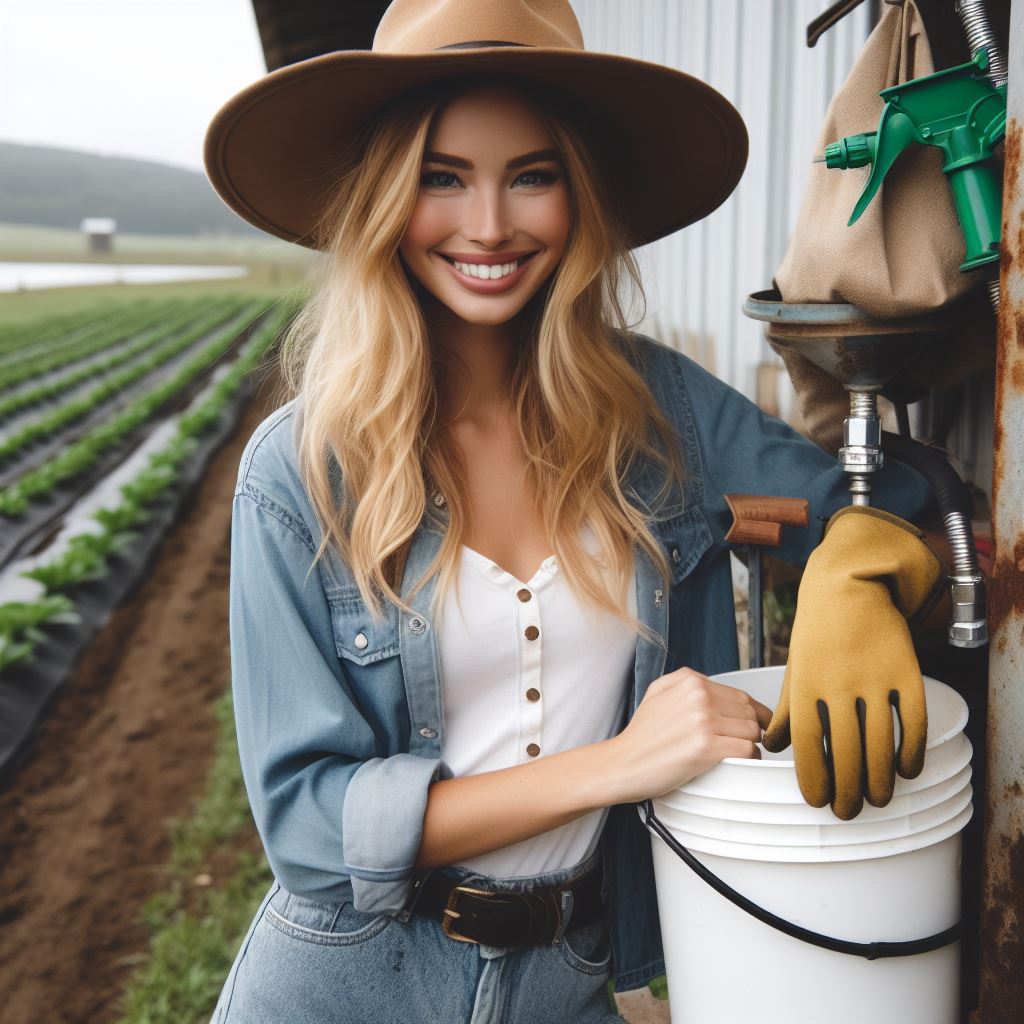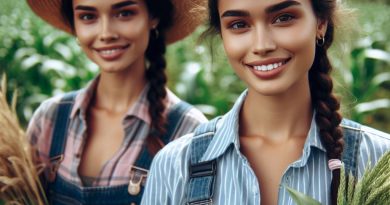Fashion to Fertilizer: Stylish Farm Beginnings
Last Updated on February 24, 2024
Introduction
Agriculture is an industry that constantly evolves, adapting to new trends and techniques.
One emerging trend that has caught the attention of the farming industry is the fusion of fashion and farming.
This unlikely combination brings a unique perspective, creating stylish beginnings for farms.
At first glance, the idea of fashion in farming may seem irrelevant. However, the reality is quite the opposite.
Fashion plays a crucial role in the farming industry, influencing everything from the clothes farmers wear to the aesthetics of farm equipment and even the packaging of farm products.
In this blog post, we will delve into the significance of fashion in farming and explore how it is revolutionizing the agricultural landscape.
We will discuss the various ways fashion is making its mark on farming, from eco-friendly clothing options for farmers to the rise of stylish farm equipment designs.
Additionally, we will examine the benefits and challenges of incorporating fashion into farming practices.
We will explore how fashion-forward farms are capturing the attention of consumers, creating a new market for sustainably produced farm products.
By embracing fashion, farmers have the opportunity to not only enhance their own style and image but also contribute to a more visually appealing and environmentally friendly farming industry. Join us on this journey as we explore the exciting world of fashion to fertilizer!
Historical Perspective: Influence of Fashion in Farming
The Role of Fashion Trends in Farming History
From ancient civilizations to modern times, fashion has always had an impact on the way farmers dress and work.
The development of agriculture coincided with the emergence of human societies, and as settlements grew, so did the need for practical and functional attire.
Early farmers wore simple and durable clothing made from animal hides and plant fibers, mainly focusing on protection from the elements and comfortable movement.
However, as societies became more complex, fashion trends emerged, influencing farmers’ attire and reflecting cultural and societal values.
Evolution of Farming Attire and Fashion’s Impact on Practicality
As time progressed, farming attire transformed from simple garments into more elaborate outfits influenced by fashion trends.
The functionality of farming attire started to incorporate more specialized elements, such as reinforced knees and elbows for durability.
The Industrial Revolution brought significant advancements in textile production, leading to the production of more sophisticated farming attire.
During the Victorian era, farmers began to wear tailored clothing, showcasing their social status and adopting fashion trends that were prevalent in urban areas.
Fashion influenced the practicality of farming attire by incorporating elements that addressed specific needs, such as pockets for tool storage and protective layers for harsh weather conditions.
Significant Fashion Statements Made by Farmers in the Past
In the early 20th century, American farmers, inspired by the rise of the cowboy aesthetic, adopted elements of Western fashion into their attire.
Wide-brimmed hats, denim overalls, and leather boots became iconic symbols of the American farmer.
During the 1960s counterculture movement, hippie farmers embraced a bohemian style characterized by tie-dye shirts, bell-bottom jeans, and sandals.
These fashion statements not only served as a means of self-expression but also influenced the overall perception of farmers in society.
By making bold fashion choices, farmers challenged the stereotype of rural life and promoted a more diverse and progressive image of the industry.
In fact, fashion trends have played a significant role in shaping farming practices throughout history.
The evolution of farming attire, influenced by fashion, demonstrates the impact of practicality and functionality.
Moreover, the fashion statements made by farmers in the past have left a lasting impact on the industry, challenging stereotypes and promoting diversity.
As farming continues to evolve, it is crucial to recognize the influence of fashion and explore ways to integrate style and practicality in farming attire.
Read: 5th Gen Corn Farmers: A Century of Growth
Fashion and Modern Farming Equipment
Fashion and Practicality in Modern Farming Attire
Fashion and practicality seamlessly merge in modern farming attire, offering farmers both style and functionality.
Today, farming clothing is designed not only to protect farmers from the elements but also to make them look fashionable.
Farmers can choose from a wide range of clothing options, including durable jeans, flannel shirts, and waterproof boots.
These attire choices not only provide comfort but also reflect the farmer’s personal style and fashion preferences.
Modern agricultural fashion has evolved to offer clothing that is both trendy and suitable for the demands of farm work.
Farmers can now enjoy the best of both worlds by looking stylish while staying safe and productive on the farm.
The Importance of Appropriate Clothing for Safety and Productivity
Using appropriate clothing is crucial for farmers as it enhances safety and productivity on the farm.
The right attire can protect farmers from potential hazards, such as sharp objects, chemicals, and extreme weather conditions.
Wearing specialized clothing ensures that farmers can carry out their tasks without worrying about personal safety.
Investing in quality farming attire can prevent injuries and accidents, reducing the economic and health-related risks associated with farming.
Moreover, appropriate clothing contributes to increased productivity by providing comfort and ease of movement.
With the right clothing, farmers can work efficiently, without restrictions, and for extended periods, if necessary.
Prioritizing the use of proper attire is a small step that leads to significant improvements in both safety and productivity on the farm.
Specialized Clothing and Protective Gear for Farmers
Various types of specialized clothing and protective gear are available for farmers to ensure their safety and well-being.
Coveralls or jumpsuits made of durable materials protect farmers from dirt, chemicals, and potential injuries.
Safety vests with reflective strips can enhance visibility, especially when working near roadways or in low-light conditions.
To shield against the sun’s harmful rays, wide-brimmed hats or caps with neck flaps offer excellent protection for the face and neck.
Furthermore, sturdy work gloves provide the necessary hand protection from cuts, abrasions, and harmful substances.
Investing in waterproof boots with non-slip soles is essential for protecting feet from moisture, slips and falls, and puncture wounds.
Farmers should also consider using safety goggles or glasses for eye protection from dust, debris, and chemicals.
In summation, the availability of specialized clothing and protective gear ensures that farmers can carry out their work safely and effectively.
When it comes to modern farming, fashion and practicality can coexist harmoniously.
Through appropriate clothing choices, farmers can elevate their fashion game while staying safe and increasing productivity.
The availability of specialized attire and protective gear further enhances the overall experience of farming.
So, whether it’s trendy jeans, flannel shirts, or waterproof boots, farmers now have a plethora of options to combine style and functionality in their daily farming endeavors.
Read: Dairy Dreams: 4 Generations of Care
The Role of Fashion in Sustainable Farming
Fashion choices aligning with sustainability practices on farms:
- Farmers can opt for long-lasting, durable clothing that minimizes waste and reduces the need for frequent replacements.
- Choosing timeless and versatile pieces allows farmers to build a functional wardrobe without contributing to the fast fashion culture.
- Investing in ethically made garments supports fair labor practices and ensures farmer’s rights are protected.
- By embracing second-hand clothing, farmers can reduce the demand for new textiles and lessen the environmental impact.
- Opting for natural fibers, such as organic cotton or hemp, helps reduce reliance on synthetic materials, which have harmful effects on the environment.
- Wearing clothing made from renewable materials like bamboo or recycled fibers promotes a more sustainable farming industry.
The use of organic and eco-friendly fabrics in farming attire:
- Organic cotton is free from toxic chemicals and pesticides, reducing harm to the environment and farm workers.
- Linen, derived from flax plants, is biodegradable and requires minimal water and pesticides during cultivation.
- Hemp, a versatile and durable fabric, can be grown without the use of harmful chemicals, making it a sustainable choice for farming attire.
- Bamboo fabric is known for its softness and breathability while being grown without the need for pesticides or excessive water.
- Recycled polyester, made from plastic bottles, offers a sustainable alternative to traditional synthetic fibers.
The growing trend of sustainable fashion in the agricultural industry:
- Many farmers are incorporating sustainable fashion practices into their daily lives as they realize the importance of environmental conservation.
- Companies specializing in farm attire are shifting towards sustainable materials and production methods to meet the demand.
- Awareness campaigns and educational initiatives help farmers understand the positive impact of sustainable fashion choices.
- Collaborations between fashion designers and farmers foster innovation in sustainable farming attire.
- Sustainable fashion shows and exhibitions highlight the integration of style and sustainability on the farm.
- Government support through incentives and funding encourages farmers to adopt sustainable fashion practices.
Fashion choices can significantly contribute to sustainable farming practices by aligning with ethical and eco-friendly principles.
By opting for durable, organic, and recycled materials, farmers can reduce waste and help protect the environment.
The growing trend of sustainable fashion in the agricultural industry indicates a positive shift towards a more conscious and responsible approach to farming attire.
Embracing sustainable fashion can benefit both the farmers and the planet, creating a more sustainable and stylish farming future.
Read: Soybean Saga: A Family’s Field History

Fashion Influence in Farm Branding
The Role of Fashion in Creating a Distinctive Farm Brand
- Fashion plays a pivotal role in creating a distinctive farm brand.
- The fashion choices made by farmers can set them apart from others in the industry.
- By incorporating unique and stylish elements into their brand, farmers can attract attention and stand out.
- Fashion is not limited to clothing; it extends to packaging, logos, and overall aesthetic.
- A well-crafted farm brand can evoke a certain lifestyle or image that resonates with consumers.
- Using fashion to create a distinctive farm brand helps build recognition and loyalty among customers.
- Distinctive farm branding through fashion can also act as a form of storytelling, connecting the farm to its products.
- By carefully considering fashion choices, farmers can effectively communicate their values and vision.
- Through fashion, a farm brand can convey a sense of quality, craftsmanship, and attention to detail.
- The role of fashion in farm branding is to create a unique identity that sets the farm apart.
Examples of Successful Farm Branding through Fashion Choices
- One example of successful farm branding through fashion is the use of custom-designed farm apparel.
- By creating clothing with their logo or farm name, farmers can create a sense of unity and pride among their team.
- A clothing line associated with the farm can also serve as a revenue stream and a way to promote the brand.
- Successful farm brands often incorporate farm-inspired patterns or elements into their clothing designs.
- By using unique patterns or prints, farmers can create a connection between their products and their brand.
- Some farms have successfully collaborated with fashion designers to create limited-edition farm-inspired collections.
- This collaboration not only strengthens the brand but also brings attention to the farm and its products.
- Another successful fashion choice in farm branding is the use of eye-catching packaging designs.
- By considering the aesthetics of their product packaging, farmers can create a memorable and visually appealing brand.
- The use of sustainable and eco-friendly materials in packaging can also enhance the brand’s image.
How Fashion Contributes to Effective Marketing and Customer Engagement in Farming
- Fashion is a powerful tool for effective marketing and customer engagement in farming.
- By utilizing fashion, farms can create a visually appealing and cohesive brand experience.
- A well-designed farm brand that incorporates fashion elements can enhance customer perception and trust.
- The use of fashion in farming can help farms target specific customer demographics and attract new customers.
- Fashion choices can communicate a farm’s commitment to sustainability, transparency, or organic practices.
- Through fashion, farms can effectively tell their story and connect with customers on a deeper level.
- Customers are more likely to engage with a farm brand that aligns with their values and lifestyle.
- Fashion can also play a role in social media marketing and digital engagement.
- Eye-catching fashion choices can generate buzz and encourage customers to share their farm experiences online.
- By creating a distinctive and memorable brand through fashion, farms can foster customer loyalty and repeat business.
In general, the role of fashion in farm branding is undeniable.
It helps create a distinctive and memorable farm brand that sets it apart from others.
Successful farm brands use fashion choices to communicate their values, create unity among their team, and engage customers.
By incorporating fashion elements into their branding strategy, farms can effectively market their products, attract new customers, and build a loyal customer base.
Read: Cattle Ranchers: 100 Years of Heritage
Fashionable Farming: Influencers and Trends
The emergence of fashionable farming influencers on social media platforms.
- Fashionable farming influencers have become a prominent presence on various social media platforms.
- These influencers share their unique farming experiences, showcasing a fusion of style and agriculture.
- By using visually appealing content, they captivate a wide audience, including both farmers and fashion enthusiasts.
- The emergence of these influencers has led to a new era in the farming community.
- They have transformed the traditional image of farmers into trendy, fashionable individuals.
The influence of these influencers on shaping fashion trends in the farming community.
- Fashionable farming influencers have played a significant role in shaping fashion trends within the farming community.
- Their ability to merge style with practicality has inspired many farmers to adopt a more fashionable approach.
- Through their content, they have introduced new clothing options and accessories, tailored specifically for farming activities.
- They promote the idea that farmers can look stylish while carrying out their daily farming tasks.
- These influencers have ignited a sense of pride and confidence among farmers regarding their fashion choices.
Current or upcoming fashion trends in farming attire.
- One of the current fashion trends in farming attire is the incorporation of vibrant colors.
- Farmers are seen opting for clothing pieces in bold shades, which add a modern touch to their overall look.
- Another popular trend is the use of sustainable and eco-friendly materials in farming fashion.
- Farmers are now conscious of the environmental impact of their clothing choices.
- They lean towards clothing made from organic fabrics or recycled materials.
- Accessories like stylish hats, gloves, and boots are also gaining attention in the farming community.
- These accessories not only offer protection but also serve as fashion statements.
- Overall, the farming community is embracing fashion trends that combine functionality with style.
Therefore, fashionable farming influencers have emerged as influential figures on social media platforms, shaping fashion trends within the farming community.
Their ability to merge style with practicality has inspired farmers to adopt a more fashionable approach.
Current trends include vibrant colors, sustainable materials, and stylish accessories.
By embracing these trends, the farming community showcases their sense of style while carrying out their agricultural activities.
Conclusion
Fashion profoundly influences farming, enhancing productivity, sustainability, and even profitability across the industry.
Your attire impacts not only your comfort but also your safety and efficiency on the farm.
Consider how your fashion choices can contribute to better performance and environmental stewardship in farming.
As we’ve explored, fashion in farming isn’t merely about aesthetics but about functionality and practicality.
Choose clothing that supports your tasks, withstands the elements, and aligns with sustainable farming practices.
Every garment you wear on the farm tells a story of your commitment to the land and its cultivation.
Let your fashion on the farm be a statement of your dedication to excellence and sustainability.
In this era of heightened environmental awareness, even your fashion choices can make a difference.
Embrace your stylish farm beginnings and inspire others to do the same for a more sustainable agricultural future.
Fashion isn’t just about what you wear—it’s about the future you cultivate.

